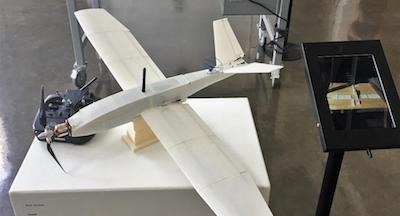Scout UAS Is Less Expensive, Easier To Fly Than Current Small Military Drones
In 2015, the U.S. Marine Corps’ Next Generation Logistics innovation group, known as NexLog, was established to “advocate for the future of emerging technologies on the front lines and for equipping Marines with the ability to make solutions for their own environment.”

With this in mind, Rhet McNeal, a 26 year-old Corporal from Griffin, Georgia, developed a 3D-printed UAS nicknamed “Scout” that is a cheaper alternative to the hand-launched, fixed-wing RQ-11 Raven and RQ-12 Wasp III UAS that the Marines currently use.
Costing $35,000 and $49,000 per unit respectively, the Raven and Wasp UAS are considered relatively inexpensive by military standards, but they are still expensive enough to where only a few Marines are authorized to fly them. The UAS also require $100,000+ ground control systems, adding to their overall value.
The UAS can be difficult to launch at times, and failed launches a lot of the times lead to crashes, which results in expensive repairs.
McNeal’s Scout UAS is far cheaper than the Raven and Wasp UAS, as the Scout, which can be controlled using the iPhone app Q Ground Control, can be built for just $613 with off-the-shelf electronics and 3D printer resin. A Scout UAS system, which includes two UAS and one control system, costs less than 0.5% of a $250,000 Wasp system.
“We have these drones that do a hundred things that make them cost between $35,000 and $50,000, but the soldiers normally only use the two or three big capabilities,” McNeal explains. “I wanted to strip it down to what we actually use so that our drone does not cost so much we are afraid to use it – if you break it, not a big deal.”
During NexLog’s 2016 Logistics Innovation Challenge, McNeal and a team of five other collaborators submitted a proposal called “Adaptable and Affordable 3D Drones,” which was a proposal for a “quick-assemble, transportable drone modeled after the Wasp but with easily printable 3D parts.” The proposal was one of 17 winning ideas selected during the challenge. By winning the Logistics Innovation Challenge, McNeal was granted access to Penn State’s Applied Research Laboratory (ARL), which is a U.S. Navy University Affiliated Research Center. It was here that McNeal first began designing the UAS and experimenting with 3D printing parts for the UAS’ wings.
The big boost in the development of the Scout UAS, though, was when McNeal participated in a 4-month residency at Autodesk’s Pier 9 technology center in San Francisco, which is a workshop that includes 3D printers, CNC machines, a woodshop, a metal shop, and software and hardware experts in every field.
McNeal’s residency began in January of this year, and he credited his work during the residency as being integral in the development of the Scout, stating that “there is no way on earth the Scout would be as good as it is today if not for the great people and equipment I was able to work with on a daily basis at Pier 9.”
Now that McNeal has completed his residency, the Scout’s design files and build specifications have been handed off to the MITRE Corporation, which supplies and tests a lot of the Marines’ UAS.
The MITRE Corporation will be responsible for carrying the Scout through the certification process and possibly, wider-scale manufacturing.
(Image provided with AUVSI news release)
 ANN's Daily Aero-Term (04.28.24): Airport Marking Aids
ANN's Daily Aero-Term (04.28.24): Airport Marking Aids Aero-News: Quote of the Day (04.28.24)
Aero-News: Quote of the Day (04.28.24) ANN's Daily Aero-Linx (04.28.24)
ANN's Daily Aero-Linx (04.28.24) Aero-News: Quote of the Day (04.29.24)
Aero-News: Quote of the Day (04.29.24) ANN's Daily Aero-Linx (04.29.24)
ANN's Daily Aero-Linx (04.29.24)



